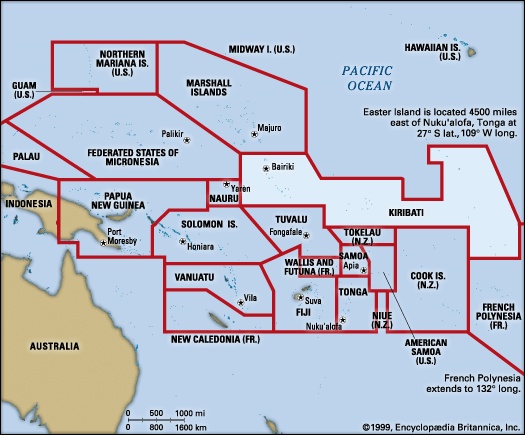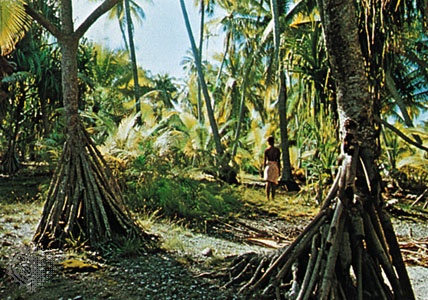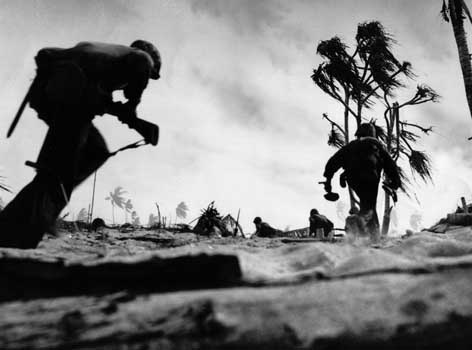Kiribati
Introduction
officially Republic of Kiribati
Kiribati, flag of island country in the central Pacific Ocean. The 33 islands of Kiribati, of which only 20 are inhabited, are scattered over a vast area of ocean. Kiribati extends 1,800 miles (2,900 km) eastward from the 16 Gilbert Islands, where the population is concentrated, to the Line Islands, of which 3 are inhabited. In between lie the islands of the Phoenix (Phoenix Islands) group, which have no permanent population. The capital and government centres are at Ambo, Bairiki, and Betio, all islets of South Tarawa in the northern Gilberts. Kiribati and Tuvalu were formerly joined as the Gilbert and Ellice Islands Colony. The name Kiribati is the local rendition of Gilberts in the Gilbertese, or I-Kiribati, language, which has 13 sounds; ti is pronounced /s/ or like the word see—thus Kiribati, pronounced “Ki-ri-bas.” Total land area 313 square miles (811 square km). Pop. (2005 prelim.) 92,533.
island country in the central Pacific Ocean. The 33 islands of Kiribati, of which only 20 are inhabited, are scattered over a vast area of ocean. Kiribati extends 1,800 miles (2,900 km) eastward from the 16 Gilbert Islands, where the population is concentrated, to the Line Islands, of which 3 are inhabited. In between lie the islands of the Phoenix (Phoenix Islands) group, which have no permanent population. The capital and government centres are at Ambo, Bairiki, and Betio, all islets of South Tarawa in the northern Gilberts. Kiribati and Tuvalu were formerly joined as the Gilbert and Ellice Islands Colony. The name Kiribati is the local rendition of Gilberts in the Gilbertese, or I-Kiribati, language, which has 13 sounds; ti is pronounced /s/ or like the word see—thus Kiribati, pronounced “Ki-ri-bas.” Total land area 313 square miles (811 square km). Pop. (2005 prelim.) 92,533.
 island country in the central Pacific Ocean. The 33 islands of Kiribati, of which only 20 are inhabited, are scattered over a vast area of ocean. Kiribati extends 1,800 miles (2,900 km) eastward from the 16 Gilbert Islands, where the population is concentrated, to the Line Islands, of which 3 are inhabited. In between lie the islands of the Phoenix (Phoenix Islands) group, which have no permanent population. The capital and government centres are at Ambo, Bairiki, and Betio, all islets of South Tarawa in the northern Gilberts. Kiribati and Tuvalu were formerly joined as the Gilbert and Ellice Islands Colony. The name Kiribati is the local rendition of Gilberts in the Gilbertese, or I-Kiribati, language, which has 13 sounds; ti is pronounced /s/ or like the word see—thus Kiribati, pronounced “Ki-ri-bas.” Total land area 313 square miles (811 square km). Pop. (2005 prelim.) 92,533.
island country in the central Pacific Ocean. The 33 islands of Kiribati, of which only 20 are inhabited, are scattered over a vast area of ocean. Kiribati extends 1,800 miles (2,900 km) eastward from the 16 Gilbert Islands, where the population is concentrated, to the Line Islands, of which 3 are inhabited. In between lie the islands of the Phoenix (Phoenix Islands) group, which have no permanent population. The capital and government centres are at Ambo, Bairiki, and Betio, all islets of South Tarawa in the northern Gilberts. Kiribati and Tuvalu were formerly joined as the Gilbert and Ellice Islands Colony. The name Kiribati is the local rendition of Gilberts in the Gilbertese, or I-Kiribati, language, which has 13 sounds; ti is pronounced /s/ or like the word see—thus Kiribati, pronounced “Ki-ri-bas.” Total land area 313 square miles (811 square km). Pop. (2005 prelim.) 92,533.Land (Kiribati)
 A few of the islands are compact with fringing reefs, but most are atolls. The largest atoll (and one of the largest in the world) is Kiritimati (Kiritimati Atoll) (Christmas) Atoll in the Line group, which has a land area of 150 square miles (388 square km) and accounts for almost half of the country's total area. Kiritimati was used for U.S. and British nuclear weapons testing in the 1960s; it now has a large coconut plantation and fish farms as well as several satellite telemetry stations. Banaba reaches 285 feet (87 metres) above sea level, the highest point in Kiribati. Its rich layer of phosphate was exhausted by mining from 1900 to 1979, and it is now sparsely inhabited. The rest of the atolls rise no higher than some 26 feet (8 metres), making them vulnerable to changes in ocean surface levels. By 1999 two unpopulated islets had been covered by the sea; the threat of rising sea levels, a theoretical result of global warming, would be disastrous for the islands of Kiribati. Average precipitation in the Gilbert group ranges from 120 inches (3,000 mm) in the north to 40 inches (1,000 mm) in the south, though all of the islands experience periodic droughts. Most rain falls in the season of westerly winds, from November through March; from April to October, northeast trade winds prevail. Temperatures are usually in the range of 80 to 90 °F (27 to 32 °C).
A few of the islands are compact with fringing reefs, but most are atolls. The largest atoll (and one of the largest in the world) is Kiritimati (Kiritimati Atoll) (Christmas) Atoll in the Line group, which has a land area of 150 square miles (388 square km) and accounts for almost half of the country's total area. Kiritimati was used for U.S. and British nuclear weapons testing in the 1960s; it now has a large coconut plantation and fish farms as well as several satellite telemetry stations. Banaba reaches 285 feet (87 metres) above sea level, the highest point in Kiribati. Its rich layer of phosphate was exhausted by mining from 1900 to 1979, and it is now sparsely inhabited. The rest of the atolls rise no higher than some 26 feet (8 metres), making them vulnerable to changes in ocean surface levels. By 1999 two unpopulated islets had been covered by the sea; the threat of rising sea levels, a theoretical result of global warming, would be disastrous for the islands of Kiribati. Average precipitation in the Gilbert group ranges from 120 inches (3,000 mm) in the north to 40 inches (1,000 mm) in the south, though all of the islands experience periodic droughts. Most rain falls in the season of westerly winds, from November through March; from April to October, northeast trade winds prevail. Temperatures are usually in the range of 80 to 90 °F (27 to 32 °C).Coconut palms (coconut palm) dominate the landscape on each island. Together with the products of the reef and the ocean, coconuts are the major contributors to village diet—not only the nuts themselves but also the sap. The gathered sap, or toddy, is used in cooking and as a sweet beverage; fermented, it becomes an intoxicating drink. breadfruit and pandanus also are grown. Cyrtosperma chamissonis, a coarse tarolike plant, can be cultivated in pits, but plants such as taro, bananas, and sweet potatoes are scarce. Pigs and chickens are raised.
People (Kiribati)
The people are Micronesian, and the vast majority speak Gilbertese (or I-Kiribati). English, which is the official language, is also widely spoken, especially on Tarawa. About half of the population is Roman Catholic, and most of the rest is Kiribati Protestant (Congregational). For many years the population of most islands has remained fairly static because of migration to the rapidly growing urban centres of South Tarawa, where more than two-fifths of the population lives. South Tarawa, including Betio, the port and commercial centre of Tarawa, has an extremely high population density. Most people live in single-story accommodations. The rural population of Kiribati lives in villages dominated by Western-style churches and large open-sided thatched meetinghouses. Houses of Western-style construction are seen on outer islands and are common on Tarawa.
Economy
 Until 1979, when Banaba's deposit of phosphate rock was exhausted, Kiribati's economy depended heavily on the export of that mineral. Before the cessation of mining, a large reserve fund was accumulated; the interest now contributes to government revenue. Other revenue earners are copra, mostly produced in the village economy, and license fees from foreign fishing fleets, including a special tuna-fishing agreement with the European Union. Commercial seaweed farming has become an important economic activity.
Until 1979, when Banaba's deposit of phosphate rock was exhausted, Kiribati's economy depended heavily on the export of that mineral. Before the cessation of mining, a large reserve fund was accumulated; the interest now contributes to government revenue. Other revenue earners are copra, mostly produced in the village economy, and license fees from foreign fishing fleets, including a special tuna-fishing agreement with the European Union. Commercial seaweed farming has become an important economic activity.An Exclusive Economic Zone of 1,350,000 square miles (3,500,000 square km) is claimed. A small manufacturing sector produces clothing, furniture, and beverages for domestic consumption and sea salt for export. The country's proximity to the Equator makes it a desirable location for satellite telemetry and spacecraft-launching facilities; several national and transnational space authorities have built or have proposed building facilities on the islands or in surrounding waters. Such projects bring capital, additional employment, and infrastructure improvements, but Kiribati continues to depend on foreign aid for most capital and development expenditure. Food accounts for about one-third of all imports, most of which come from Australia and Fiji, and Japan and Thailand are the major export destinations. Although South Tarawa has an extensive wage economy, most of the people living on outer islands are subsistence farmers with small incomes from copra, fishing, or handicrafts. These are supplemented by remittances from relatives working elsewhere. Interisland shipping is provided by the government, and most islands are linked by a domestic air service. Tarawa and Kiritimati have major airports.
Government and society
Kiribati has a president elected by the populace from among three or four candidates chosen by and from members of the national legislature, the unicameral House of Assembly (Maneaba ni Maungatabu). The president can serve up to three terms of four years each, but terms may be cut short by a vote of the legislature. The House of Assembly has 42 members—40 elected; 1 appointed from the expatriate Banaban community on Rabi Island in Fiji; and the attorney general, who serves as an ex officio member—who serve four-year terms. The president chooses up to 10 cabinet ministers from the legislature, and they remain responsible to it. Local government is through elected island councils.
Primary education is compulsory, and selected pupils attend government- or church-run secondary schools. Kiribati conducts its own technical and teacher training, and the University of the South Pacific operates a centre on Tarawa that offers degree and certificate programs, but other higher education opportunities must be pursued overseas. There are hospitals on Tarawa and Kiritimati and clinics on all of the inhabited islands.
Cultural life
Kiribati society remains conservative and resistant to change; ties to family and traditional land remain strong, and conspicuous displays of individual achievement or wealth are discouraged. The building and racing of sailing canoes is a common pastime. Musical composition and dancing in customary styles are regarded as art forms and are the basis of widespread competition. Volleyball and football (soccer) are popular sports.
History (Kiribati)
The first settlers in the Gilbert Islands and Banaba came from Southeast Asia, by way of Micronesia, some 4,000 to 5,000 years ago. About the 14th century AD the southern islands received an influx of Samoans, and soon thereafter the islanders adopted a gerontocratic style of government (i.e., based on rule by elders). The Line and Phoenix islands had no prehistoric population.
Spanish explorers sighted some of the islands in the 16th century, but most of Kiribati was not charted until the early 19th century, when first whalers and then coconut oil traders reached the islands. From the mid-19th century, Gilbert Islanders were recruited to work on plantations elsewhere in the region.
The Gilbert Islands became a British (British Empire) protectorate in 1892, and Banaba was annexed in 1900 after the discovery of its rich phosphate deposits. Both were linked with the Ellice Islands (now Tuvalu) as the Gilbert and Ellice Islands Colony from 1916; the colony subsequently was extended to include most of the Phoenix and Line island groups and, for a time, Tokelau. Administration was through island governments, which sometimes became enmeshed in sectarian rivalries between Roman Catholics and Protestants. As a response to drought and perceived overpopulation in the 1930s, a resettlement plan was initiated for the Phoenix Islands; under a later plan, other islanders were resettled in the Solomon Islands.
 During World War II the islands were occupied by Japan, which was later ejected by Allied forces. The colony had few services until aid-funded development programs were introduced after the war. An elected House of Representatives was established in 1967. The subsequent emergence of ethnic tensions led to the division of the Gilbert Islands and the Ellice Islands into two territories in 1975–76. In 1971 the Banabans sued the British government for a greater share of royalties from phosphate mining and compensation for the island's environmental devastation. The trial ended inconclusively and without a court order to have the mining company restore the land, the outcome for which the Banabans had hoped. In 1981 the community agreed to Britain's offer of a one-time trust payment of $10 million (Australian) in return for the abandonment of further litigation. The Gilbert Islands achieved independence under the name Kiribati in 1979.
During World War II the islands were occupied by Japan, which was later ejected by Allied forces. The colony had few services until aid-funded development programs were introduced after the war. An elected House of Representatives was established in 1967. The subsequent emergence of ethnic tensions led to the division of the Gilbert Islands and the Ellice Islands into two territories in 1975–76. In 1971 the Banabans sued the British government for a greater share of royalties from phosphate mining and compensation for the island's environmental devastation. The trial ended inconclusively and without a court order to have the mining company restore the land, the outcome for which the Banabans had hoped. In 1981 the community agreed to Britain's offer of a one-time trust payment of $10 million (Australian) in return for the abandonment of further litigation. The Gilbert Islands achieved independence under the name Kiribati in 1979.After independence a high priority was given to economic development, especially the exploitation of marine resources and the use of the country's strategic position astride the Equator for space launch and tracking projects. Both Japan and China constructed Earth-satellite telemetry stations in the late 1990s, although China dismantled its facilities after Kiribati shifted its formal recognition of China to Taiwan in return for economic assistance in 2003. A commercial satellite-launch platform located on a converted oil-drilling rig east of Kiritimati began operation in the late 1990s. Kiribati belongs to the Pacific Islands Forum, the International Whaling Commission, the Commonwealth, and the United Nations.
Additional Reading
Tony Whincup, Nareau's Nation: A Portrait of the Gilbert Islands (1979), offers insights into modern life. Rosemary Grimble (ed.), Migrations, Myth, and Magic from the Gilbert Islands: Early Writings of Sir Arthur Grimble (2004; originally published 1972), gives an account of myth, legends, and traditions. Gerd Koch, The Material Culture of Kiribati (1986; originally published in German, 1965), is an anthropological study. Alaima Talu et al., Kiribati: Aspects of History (1979, reprinted 1984); and Peter McQuarrie, Conflict in Kiribati: A History of the Second World War (2000), include the perspective of Kiribati's indigenous people. Albert F. Ellis, Ocean Island and Nauru: Their Story (1935), is an account by a New Zealander and discoverer of phosphate in the islands. Barrie Macdonald, Cinderellas of the Empire: Towards a History of Kiribati and Tuvalu (2001), is comprehensive. A useful guide is Norman Douglas and Ngaire Douglas (eds.), Pacific Islands Yearbook, 17th ed. (1994).
- Pascoli, Giovanni
- Pascual Cervera y Topete
- Pascual Jordan
- pas de deux
- pas d'élévation
- Pasek, Jan Chryzostom
- pasha
- Pashto language
- Pashtun
- Pashupata
- Pashupati
- Pasig River
- Pasinetti, Francesco
- Pasiteles
- Paskevich, Ivan Fyodorovich, Graf Yerevansky, Knyaz Varshchavsky
- Paso, Fernando del
- Pasolini, Pier Paolo
- Paspalum
- Pasquale Fiore
- Pasquale Paoli
- Pasquale Stanislao Mancini
- Pasquier Quesnel
- Pasquier, Étienne
- Pasquier, Étienne, duc de
- pasquinade